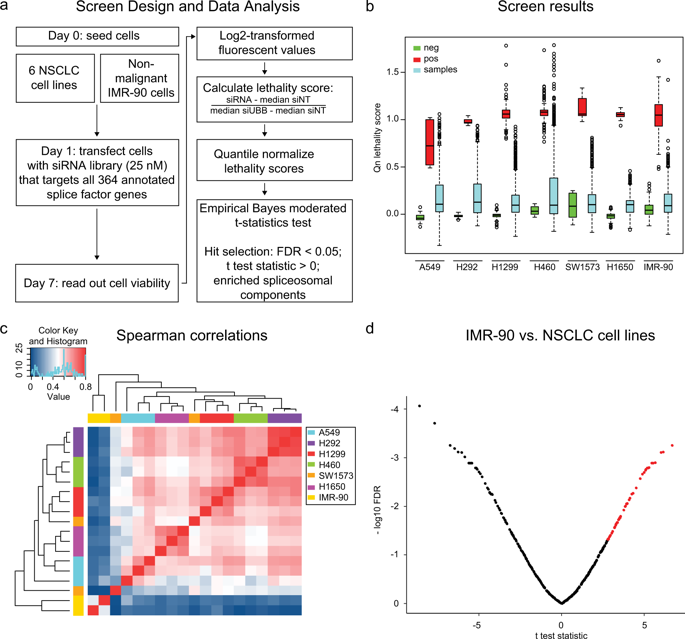Our official English website, www.x-mol.net, welcomes your feedback! (Note: you will need to create a separate account there.)
High-throughput RNAi screening reveals cancer-selective lethal targets in the RNA spliceosome.
Oncogene ( IF 8 ) Pub Date : 2019-01-31 , DOI: 10.1038/s41388-019-0711-z Maxime Blijlevens 1 , Ida H van der Meulen-Muileman 1 , Renée X de Menezes 2 , Egbert F Smit 3 , Victor W van Beusechem 1
Oncogene ( IF 8 ) Pub Date : 2019-01-31 , DOI: 10.1038/s41388-019-0711-z Maxime Blijlevens 1 , Ida H van der Meulen-Muileman 1 , Renée X de Menezes 2 , Egbert F Smit 3 , Victor W van Beusechem 1
Affiliation

|
Novel therapeutic strategies for non-small-cell lung cancer (NSCLC) are urgently needed. RNA splicing, orchestrated by the spliceosome, is deregulated in many forms of cancer, including NSCLC. Here, we performed high-throughput screening with a small interfering RNA library targeting all annotated human spliceosome proteins to identify cancer-selective lethal targets in the RNA splicing machinery. Silencing of several spliceosome proteins reduced cell viability in a panel of NSCLC cell lines, but not in non-malignant lung fibroblasts and epithelial cells. Interestingly, the cancer-selective lethal target set comprised all seven Sm proteins that, together with small nuclear RNA, form the core structure of most spliceosome subunits. Interfering with Sm protein expression induced apoptosis in NSCLC cells, but not in non-malignant cells. In silico analysis revealed that Sm proteins are frequently upregulated in NSCLC. For several Sm proteins, increased expression showed a positive correlation with disease severity. Together, our results suggest that the Sm proteins represent particularly useful novel targets for selective treatment of NSCLC.
中文翻译:

高通量RNAi筛查揭示了RNA剪接体中的癌症选择性致死靶标。
迫切需要针对非小细胞肺癌(NSCLC)的新型治疗策略。由剪接体精心编排的RNA剪接在包括NSCLC在内的多种癌症中均失控。在这里,我们用针对所有带注释的人类剪接体蛋白的小干扰RNA文库进行了高通量筛选,以鉴定RNA剪接机制中的癌症选择性致死靶标。沉默几种剪接体蛋白会降低一组NSCLC细胞系的细胞活力,但不会降低非恶性肺成纤维细胞和上皮细胞的活力。有趣的是,对癌症具有选择性的致死靶标包含所有七个Sm蛋白,它们与小核RNA一起构成了大多数剪接体亚基的核心结构。干扰Sm蛋白表达可诱导NSCLC细胞凋亡,但不会诱导非恶性细胞凋亡。计算机分析表明,Sm蛋白在NSCLC中经常被上调。对于几种Sm蛋白,表达增加与疾病严重程度呈正相关。总之,我们的结果表明Sm蛋白代表了选择性治疗NSCLC的特别有用的新型靶标。
更新日期:2019-01-31
中文翻译:

高通量RNAi筛查揭示了RNA剪接体中的癌症选择性致死靶标。
迫切需要针对非小细胞肺癌(NSCLC)的新型治疗策略。由剪接体精心编排的RNA剪接在包括NSCLC在内的多种癌症中均失控。在这里,我们用针对所有带注释的人类剪接体蛋白的小干扰RNA文库进行了高通量筛选,以鉴定RNA剪接机制中的癌症选择性致死靶标。沉默几种剪接体蛋白会降低一组NSCLC细胞系的细胞活力,但不会降低非恶性肺成纤维细胞和上皮细胞的活力。有趣的是,对癌症具有选择性的致死靶标包含所有七个Sm蛋白,它们与小核RNA一起构成了大多数剪接体亚基的核心结构。干扰Sm蛋白表达可诱导NSCLC细胞凋亡,但不会诱导非恶性细胞凋亡。计算机分析表明,Sm蛋白在NSCLC中经常被上调。对于几种Sm蛋白,表达增加与疾病严重程度呈正相关。总之,我们的结果表明Sm蛋白代表了选择性治疗NSCLC的特别有用的新型靶标。



























 京公网安备 11010802027423号
京公网安备 11010802027423号